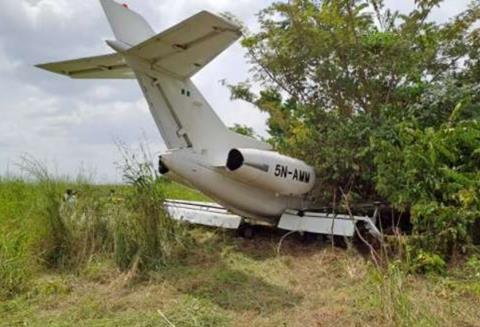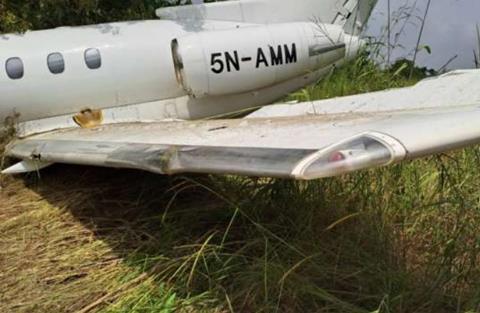Nigerian investigators have yet to determine why a Raytheon Hawker 800XP touched down more than 200m short of the runway during a night approach to Ibadan airport last month.
The executive jet, operated by Flints Aero Services, suffered substantial damage after initially landing 220m before the threshold of runway 22 while conducting an area navigation approach.
It struck several rows of approach lights – hitting one row before touchdown – then entered the paved area. Six impact points were discovered.
The aircraft (5N-AMM) subsequently veered to the right, exiting the right-hand side of the runway after travelling 156m, and came to rest about 28m further on after being snared by vegetation.

Visibility was good at the time, with no significant meteorological conditions. Ibadan’s VOR/DME navigation aid was not functioning on the date of the accident, 3 November.
Preliminary findings from the Nigerian Safety Investigation Bureau point out that – while the aircraft was listed as having seven passengers as well as three crew members, none of whom was injured – the operator had a permit for non-commercial flight and was not licensed to transport fare-paying occupants.
The pilots, with the first officer flying, were operating their third sector of the day, a charter from Abuja.
According to the safety bureau the operator filed a flightplan requesting that the airport remain open for 2h beyond its normal hours to accommodate the arrival.

The crew was cleared to descend to 3,500ft for the area navigation approach to runway 22, and reported the runway in sight some 8min later. Air traffic control granted landing clearance, which the crew acknowledged.
About 5min later, the inquiry says, the tower controller attempted to contact the crew, with no reply. The controller called another eight times, but did not receive a response, and notified the emergency services.
Airport firefighting personnel located the aircraft in an overgrown grassy area off the right side of the runway. Its landing-gear had collapsed, and it sustained damage to the wing, fuselage and flaps.
Investigators have recommended that the airport’s operating hours should be “strictly” observed, while Flints Aero Services should be instructed to operate “within the limits” of its approval, and ensure its pilots have sufficient experience in night flying.


























